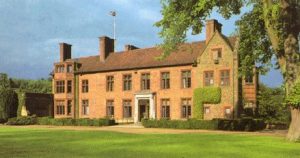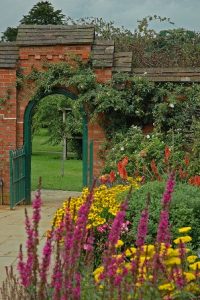
Residences
“This Demi-Paradise”: Lullenden

Winston Churchill, Parliament Square, London © Sue Lowry & Magellan PR
April 3, 2009
Winston and Clementine Churchill’s First Country Home
by ROGER WILKES
Mr. Wilkes’s article appeared in The Daily Telegraph of 20 October 2001, and is reprinted by kind permission of The Telegraph Group Ltd. Other articles on Lullenden appear in FH 48, 93, 103, and 110.
Lullenden is a heart-of-oak house with all the yeoman qualities of its most celebrated owner, Winston Churchill, who lived there from the spring of 1917 until November 1919. Unlike Chartwell, which Churchill bought in 1924, it is neither great nor particularly grand. But it is old, warm and welcoming.
When Churchill bought Lullenden, a Tudor manor set in 77 acres of south-east Surrey, with the help of his mother, he was 42 and fighting in the First World War. No longer ruler of The King’s Navy—he had resigned as First Lord of the Admiralty over the Gallipoli fiasco and the Dardanelles—he stormed off to command a battalion at the front. Chastened and widely vilified, “the escaped scapegoat” had no wish to stay in the cabinet, and hoped to find glory in uniform instead.

2024 International Churchill Conference
But having installed his wife and family in the country, by July 1917 he was back in government as Minister of Munitions—something of an irony as the point of buying Lullenden was to move his children away from the bombing raids on London.
Churchill’s wife Clementine helped entertain his important visitors at Lullenden. War or no war, she loved the gardens that enclosed the house and gave the family privacy. “On Saturday, I want you to take me to Crawley in the motor,” she instructed Churchill in July 1918, “to see Cheal’s Nursery Gardens. I want to buy some little rock plants to put in the chinks everywhere.”
Their children, Diana, eight, Randolph, six, and three-year-old Sarah, were joined at Lullenden by their cousins, Johnnie and Peregrine, aged eight and three, the sons of Churchill’s brother, Jack, and his wife Goonie (known in the family as “the Jagoons”). Apparently, the five of them made such a noise that Churchill installed them in the barn—now a four-bedroom house—along with the family’s Scottish nanny, Isabelle, so that at weekends, when he returned from his ministerial duties, he could think great thoughts in the main house undisturbed.
To relax, he painted (at least three of his pictures of Lullenden have survived) and planted. In the wooded grounds, Churchill’s wild white cherry trees, white magnolias, crimson Japanese azaleas and blood-red Britannia rhododendrons (one of Clementine’s favourites) still give blazes of colour in season.
“Any weekends he was not in France, Winston spent at Lullenden, which was conveniently situated near the airfields of Penshurst and Godstone,” his daughter Mary Soames, born in 1922, recalled. Churchill clearly enjoyed them. “Dearest & best beloved,” he wrote to Clementine from Paris towards the end of the war, “let me know what plans you make for Lullenden next Sunday.”
The children went to school in the nearby village of Dormansland in a pony and trap. Here, at the age of five, Randolph discovered that his father was different from other fathers. “Will you be my chum?” Randolph asked another little boy. The child refused, explaining: “Your father murdered my father.”
“What do you mean?”
“At the Dardanelles.”
But not all Randolph’s memories of Lullenden were so dark. He recalled playing a variant of hide-and-seek with his father in the wooded grounds, and remembered returning from school one day to find the gardener up a ladder nailing a Union Flag to a flagpole to celebrate the Armistice.
The heart of the nine-bedroom house is the great hall. A soaring, double-height room with a vaulted ceiling, it is lit by a wrought-iron electrolier suspended from a great oak tie-beam and warmed by a roaring fire set in the inglenook that, at eight feet wide, would roast half an ox. The date 1624 is cut into the massive oak bressummer, while the iron fire-back is dated 1582, further evidence of Lullenden’s Elizabethan origins.
Up the oak staircase is the 27-foot master bedroom where the Great Man slept. Double-aspect windows give views across the countryside, and to one side of the massive bed, a tiny Judas-window allows a glimpse down into the great hall.
In the postwar Government, Churchill was appointed Secretary of State for War and Air, dealing with, among other things, the demobilisation of nearly three and a half million soldiers. But in the midst of his turbulent public life, he suffered a great domestic blow. Isabelle, who had been the Churchills’ nanny for years, died suddenly in the flu epidemic of 1919. Later that year Winston and Clementine decided reluctantly to sell Lullenden.
“I feel very anxious about our private affairs,” wrote Clementine to her husband. “It’s clear we are far too much extended.” But it seems not to have been simply a question of money. Perhaps because of the chaotic life they led, between London and the country, France and England, Lullenden had become run down.
Their new head gardener had insisted on a major overhaul of the grounds, ploughing up some of the fields to sow corn and employing labourers for the heavy work. This energetic man moved the greenhouse with his own hands, telling Clementine that, without these changes, “the place will always be a dead weight of expense,” but that “afterwards it will certainly pay.”
With Churchill so busy elsewhere, Clementine had taken the gardener on without her husband seeing him first. While she admired the gardener’s “great decision and apparent knowledge,” she felt browbeaten. “If we sell Lullenden,” she told her husband, “we can pass this tyrant on with the place!” In the end, it came to a hard choice. “It’s no use going on in this moribund condition.” So, at the end of 1919, the Churchills sold Lullenden to their old friends, General Sir Ian and Lady Hamilton.
Today, Lullenden, one of the few small country estates to have survived intact, is for sale again. “The house is manageable,” says Gavin Selbie, a partner at Knight Frank’s Tunbridge Wells office, “but it’s also got the space. It offers an idyllic rural lifestyle, and for a family, Lullenden is magic.”
Subscribe
WANT MORE?
Get the Churchill Bulletin delivered to your inbox once a month.




